ISSN ONLINE(2319-8753)PRINT(2347-6710)
ISSN ONLINE(2319-8753)PRINT(2347-6710)
S.S. Bhattacharya1, Aadhar Mandot2
|
| Related article at Pubmed, Scholar Google |
Visit for more related articles at International Journal of Innovative Research in Science, Engineering and Technology
PP/nanoclay nonwoven composites were prepared by spun bond technology on spunbonding machine. The prepared nonwoven composites were characterized by SEM and EDX techniques. The thermal properties were analyzed using DSC, revels lower Tg inflection point as well as ï„H value for nonwoven with nanoclay addition. This composite nonwoven fabric was also evaluated for the change in their mechanical properties. The tensile strength was found increased with the addition of nanoclay. The tear strength of pp/nanoclay nonwoven was also found improved, compared to the nonwoven prepared without the addition of nanoclay.
Keywords |
| Polypropylene; Nanoclay; Nonwoven; Thermal property; Mechanical property. |
INTRODUCTION |
| Polypropylene having numerous advantages in our day to day life but suffers from major disadvantage of being highly flammable and organic in nature, which limits its wider application. To make wider applicability of polypropylene, a major challenge in research is to enhance the fire retardant and heat resistance properties of polymer [1]. Nanocomposites are the type of materials, where at least one dimension of the particle added should be in nanometer range. Nanocomposites are generally made up of organic polymer with nanosize inorganic particles dispersed in it, which leads to dramatic increase in interfacial area as compared with traditional composites [1-3]. They combine the advantages of the inorganic material (e.g., rigidity, thermal stability) and the organic polymer (e.g., flexibility, dielectric, ductility, and processability) [4-13]. Generally, inclusion of clay particles enhance the thermal stability of polymers by acting as thermal insulator and mass transport barrier [14-16] to the volatile products generated during decomposition. However, it is very difficult for the hydrophilic clay (montmorrilonite) to be exfoliated and well - dispersed in a hydrophobic polymer matrix. Therefore, organically modified clay (organoclay) is generally used where interlayer spaces of clay particles are made to expand to allow polymer molecules to inter in. Melt intercalation is most commonly used, being solvent less approach to synthesize polymer/clay nanocomposites. Method involves diffusion of the polymer chains into the space between the galleries of organoclay [17,18]. Conventional flame retardants are required in large quantity to make the polymer fire retardant which may affect the processing of polymer. By use of organically modified clay (nanoclay), interaction between the clay particles and the polymer matrix has been enhanced [19,20]. Polypropylene (PP) is a semicrystalline engineering thermoplastic commodity polymer that finds widespread use in various applications. Recently much attention has been focused on Polypropylene /organoclay nanocomposites preparation by melt blending method [21], which is a solvent free approach and industrial viable to synthesize polymerclay nanocomposite and broadly applicable to many polar and nonpolar polymers. In this study, nonwoven fabric of PP and PP/nanoclay composite were prepared by spun bond technique on lab spunbonding machine. The composites were characterized by SEM and EDX. The thermal behavior of the composites was investigated through differential scanning calorimetry (DSC). Finally, the mechanical properties were measured using standard methods. |
II. MATERIALS AND EXPERIMENTAL METHODS |
| MATERIALS: Polypropylene polymer fibre grade chips of 35 MFI were procured from Reliance Industries. Organoclay (Natural montmorillonite modified with CTAB) was prepared in lab. The nanoclay is represented as NM in this study. All these materials and chemicals were used without further purification. The composition of various PP/nanoclay nonwoven composites is given in Table 1.PREPARATION OF PP/NANOCLAY COMPOSITES: PP and nanoclay with desired proportions (Table 1) was melt blended using single screw extruder (Maxwell mixing extruder, ¾ inch dia.) with a feed rate of 200 g/h to yield the composites. Prior to extrusion, PP pellets were oven dried at 85 oC for 10 h and grinded to obtain coarse material. Extrusion was performed within the temperature range 240−250 oC at a screw speed of 30 rpm. Spun bond fabrics were produced using Lab model spun bonding machine. The machine consists of extruder with four zone heating and a heated spinning head with metering pump. The measured quantity of material which comes of the spinneret suddenly enters into the stretching zone. The chamber consists of air suction and distributing unit, which stretches the filaments a high rate and then uniformly distributes on the conveyor below. This prepared layer is further passed through pair of heated rollers to make an uniform nonwoven fabric. A control sample with pure PP chips was also prepared for comparative study at same machine parameters. Processing conditions maintained for the production of different samples are optimized. Extruder and spinning conditions were maintained same for all the samples with the target fabric weight of 160 grams per square meter (GSM). All the samples produced in the experiments were conditioned for 24 hours under standard textile laboratory conditions before testing and evaluation. |
 |
CHARACTERIZATION OF PP/NANOCLAY COMPOSITES |
| a) Surface morphology and elemental analysis : SEM and EDX measurements were performed with scanning electron microscope (Model JSM-5610 LV Japan) equipped with Oxford Inca software. b) Thermal characterization : The thermal characterizations of nonwoven were analyzed using differential scanning calorimetry (DSC model 6000 from PerkinElmer, Singapore) temperature range from 50°C to 300°C at a heating rate of 10 oC /min under constant nitrogen flow of 50 mL/min. c) Mechanical testing : For testing the mechanical properties, the specimens were conditioned at 65± 2 % relative humidity and 27 ± 2°C before physical testing. The breaking strength in gf/mm2 of nonwoven with different concentration was measured on tensile tester (LRY model, Lloyd, U K), with 50 mm/min speed and 20 mm gauge length. |
III. EXPERIMENTAL RESULTS AND DISCUSSION |
| Polypropylene / clay nanocomposite nano woven fabric was prepared with addition of nanoclay particles in different proportions viz., 0.1, 0.4, 0.7, 1 & 1.6 into polymer matrix. The PP/clay nanocomposite material was prepared on lab model spun bond nonwoven machine. PREPARATION OF POLYPROPYLENE / NANOCLAY COMPOSITE NONWOVEN FABRIC : As evident from studies that the viscosity of samples with the nano additives is higher than that of the samples prepared with pure |
| polypropylene. The main effect of these viscosity differences was on the processability, where the pressure in the spin pack increased with increase in viscosity. This may require the use of higher melt temperature for proper processing. However, in this study, the melt temperatures were kept same. Processing was almost without any major problem up to 1% addition nano clay particles. Also, it was observed that processability was not very good for more than 1% addition of nanoclay particles. With higher level addition of (1.6% in this case) of clay in fabric, there was increase in back pressure and polymer flow problem in the die. To avoid any further problem, at this stage the metering pump 1 was increased to 5, which increased the through put value from 0.09 gms / hole / min to 0.11 gms / hole / min. For maintaining the GSM, minor increase in take-up speed was done. Since, the run was carried out only for short duration, no possible buildup on spinneret face was observed. Samples prepared with different composition of PP and nanoclay are shown in Fig. 1. However, there was drip formation after a while and good quality fabrics could not be collected especially with higher than 1.6 % addition of nanoclay in composite samples. |
 |
| SEM ANALYSIS : From the SEM micrographs as in Fig. 2 good bonding was observed for samples with and without nanoclay addition. From the comparison of SEM micrographs of bond points with additive and without additive, it is clearly evident that, presence of nanoclay up to 1% leads to stronger and uniform fabrics by improving the properties of fibers and the quality of bonding. However, careful examination of several bond points revealed difference in bond point and surface microstructure. SEM micrographs indicate that the fibers with additive maintain better integrity during calendering. Increased clay loading had adverse effect on the surface topology. Going to higher levels of nanoclay does not show further improvement, may be due to difficulties in getting better dispersions and exfoliation of clay in the polymer. |
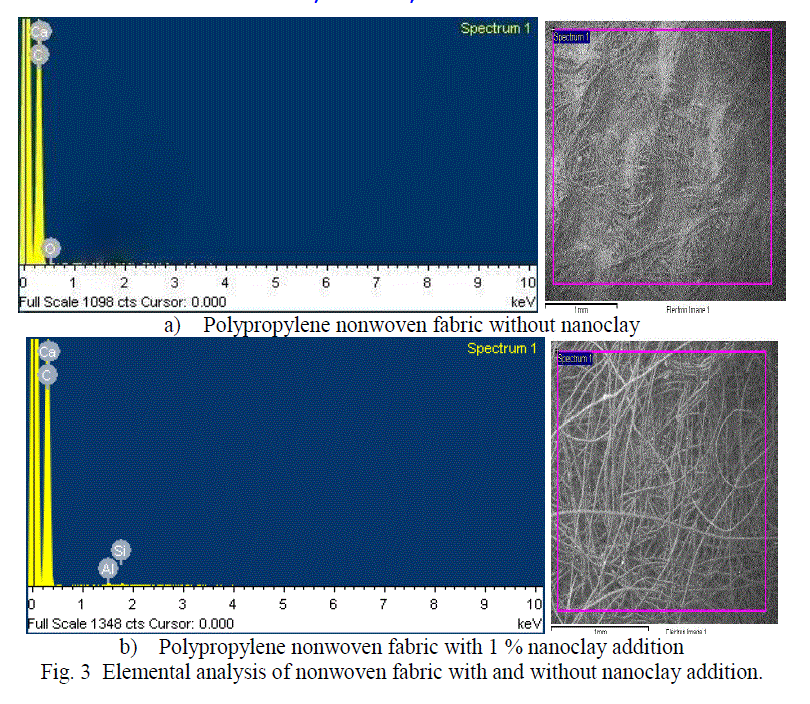 |
| EDX ANALYSIS : EDX scan of sample without nanoclay and with 1wt. % nanoclay are shown in Fig. 3. The EDX curve (b) of PP with nanoclay exhibits two intense peaks for Si and Al which is absent in curve (a) for neat PP nonwoven. |
| THERMAL ANALYSIS : Fig. 4(a) shows the differential scanning calorimetry (DSC) curve of pure polypropylene nonwoven fabric. Here the pure polypropylene nonwoven sample was heated at 10°C/min rate up to 300°C, in which it shows the T° peak temperature of the polypropylene nonwoven fabric as 163.64°C and the total heat required to melt i.e. enthalpy (ΔH) is 350.52 mJ. |
 |
| Fig. 4 (b & c) shows the DSC curves of nanocomposite nonwoven fabric of polypropylene and clay nanoparticles at 1.0% and 1.6%. The T° peak temperature and enthalpy of both the composite fabric are given in Table 2. The T° peak temperature of nanoclay polypropylene composite non woven is 162.81°C and 163.67 respectively for 1.0% and 1.6% nanoclay loaded PP composite nonwoven fabric. Data shows there is no significant effect on melting temperature of all the nanocomposite fabric due to addition of clay nanoparticles. From the results the ΔH value initially decrease with 1 wt. % addition of nanoclay but it is further increased with the increase in 1.6 wt. % of nanoclay loading. There is no significant change in T° peak value as well as onset temperature of the samples; however the Tg inflection point was found decreased with the addition of nanoclay compared to the web produced without the addition of nano filler. This may be due to the segregation of clay platelets at the spherulite boundary, similar results was also reported by Maiti et al. in their studies on polymer/clay hybrids [22]. The Tg inflection point as well as the ΔH value was found lower for nonwoven with nanoclay addition, this may be due the hindrance of nanoclay particles to the intermolecular structure of PP because of uniform dispersion. |
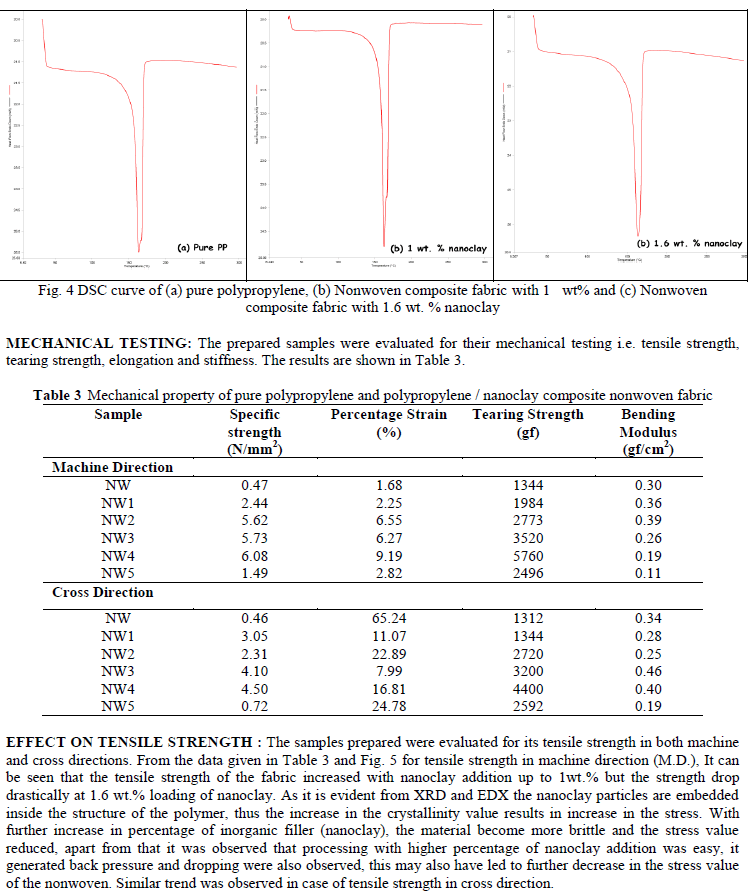 |
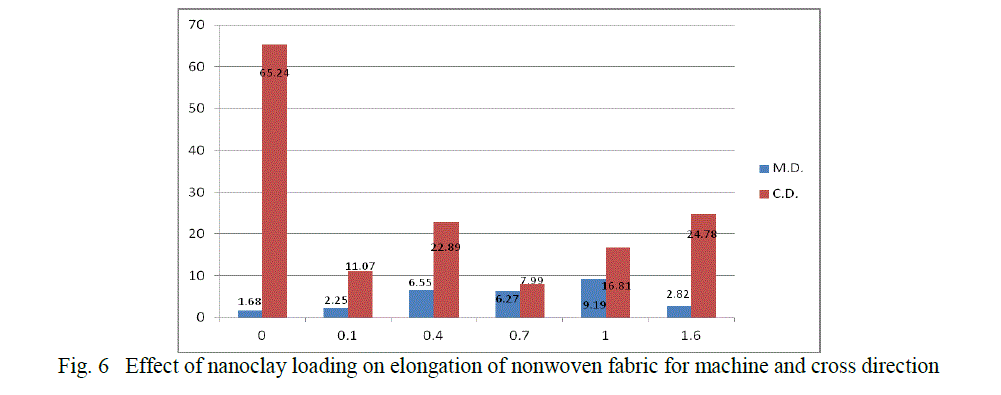 |
| EFFECT ON STRAIN : Results obtained for elongation of nonwoven fabric as shown in Table 3, they are converted in % strain to have proper comparison. Normally, elongation is mainly concerned with the deformation of the amorphous regions in which the primary and secondary bonds are stretched and sheared. From the results obtained and Figure 6 for machine direction, it is observed that with the incorporation of the nanoparticles, along with the stress value the percentage elongation also increases, which is an unique feature. Normally, the elongation of the material decreases with increase in stress value, but due to structural difference of material i.e. nonwoven it can be due to reduced bonding points. From SEM micrographs, it has also been observed that the overall structure of the spun bond nonwoven fabric becomes open with increase in nanoclay loading. This may have resulted in generation of uneven bond points which lead to the unpredictable behaviour of strain %. Though the incorporation of nanoclay material inside the structure of polymer has increased the stress value but reduced bond points has reduced inter friction, which results in slippage and increased strain percentage. The results obtained for percentage strain in case of cross direction indicates no significant trend. It has been clearly seen from the Fig. 6 that addition of 0.1 wt % nano clay increased the strain but addition of 0.4, 0.7, 1.0 and 1.6 wt % nanoclay resulted in mixed variation in strain values. These observations are not showing any trend or particular behaviour, as per theory, the strain % should reduce with the addition of filler material but we are not getting such results, may be due to the method of spun bond production. |
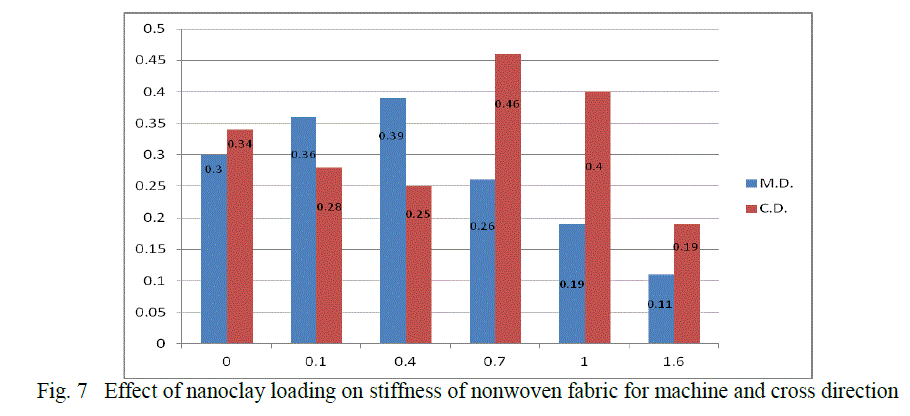 |
| EFFECT ON BENDING MODULUS : Bending length is the length of the fabric that will bend under its own weight to a definite extent. Bending length and Flexural rigidity are the measure of stiffness that determines draping quality. From the Fig. 7, it is seen that bending length and flexural rigidity almost remains unchanged with the addition of nanoclay, slight increase in the bending length and flexural rigidity is observed up to 0.4 wt. % of nanoclay addition which is not significant but with further addition of clay the material becomes limpy. This can be due to less bonding points as seen from SEM at higher percentage of clay addition. In the case of cross direction, the change in the bending length and flexural rigidity is not significant. |
| Bending modulus is a value independent of dimension of strip tested and is regarded as ‘intrinsic stiffness’. It can be seen from the Fig. 7, which represents the data of bending modulus for machine direction, it is observed that bending modulus increases with the nanoclay addition in the polymer matrix. This trend is up to 0.4 wt% nanoclay addition but at the same time the change is not significant. However there is minor decrease in the bending modulus beyond 0.4 wt% nanoclay addition. This may be due to the small size of the nano particles which do not interfere in the polymer matrix or web. At the same time, the inorganic matter inside and outside the polymer matrix, did not allow to increase the bonding points. Fig. 7, also presents bending modulus for cross direction of the prepared nonwoven fabric, which gives no significant trend of the modulus / stiffness of the material. However, it can be seen that the bending modulus of the material decreases. |
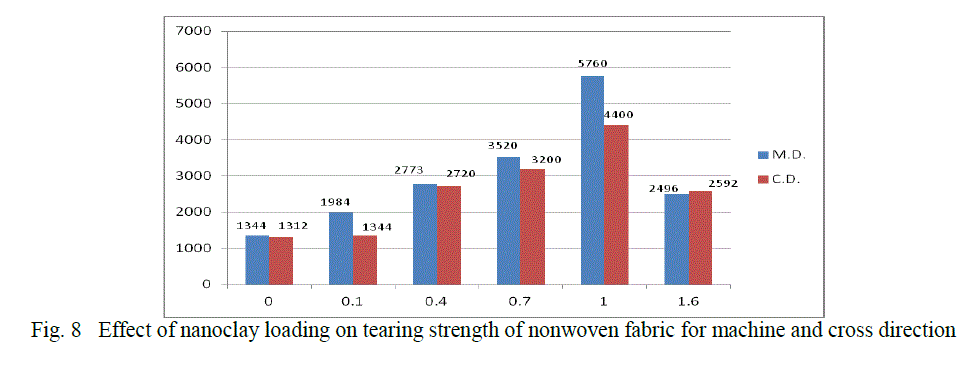 |
IV. CONCLUSION |
| PP/nanoclay nonwoven nanocomposites fabric was successfully prepared by spun bond technique. SEM and EDX showed uniform distribution of nanoclay upto 1 wt % loading. The DSC data indicated that the Tg inflection point as well as the ïÃÂÃâH value was found lower for nonwoven with nanoclay addition. There is an increase in tensile strength and strain as a function of filler wt % added [0.1 to 1.0 wt %]. Abrupt decrease in mechanical property was observed at 1.6 wt % addition of nanoclay in PP nonwoven fabric. The application of such nonwoven composite fabric can be at various fields like food packaging, medical and biological applications. This also can be very useful product for automobile industry. |
References |
|